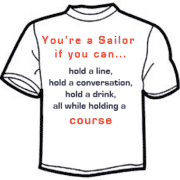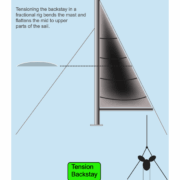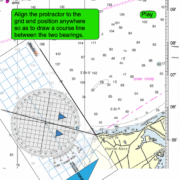How to sail in light winds
Sailing in Light winds
Sailing in light air is certainly a skill that needs to be taught by sailing schools when learning to sail. But, here are some very key points you can learn that will get you moving through the water on light wind days.
Light air sailing is very much a learned skill. There are a few tricks to it and once learned can create excellent light air sailing experiences when others are turning on their stinky engines.
In days gone by, I owned a 1979 Seidlemann 29 ft sailboat. What a great sailboat that was with many a story generated. The location: Lake Travis in Austin Texas. Sailing in Lake Travis is a great place to learn to sail because; the winds are so shifty from the high cliffs surrounding the lake, the winds can get high when fronts come rolling through and the winds can drop right off to almost nothing on warm summer evenings. And this is when the light sailing skills came in. Many times, we’d be out at night and the winds would be 2-3 knots with an air temperature of 80 deg F (26 deg C). Ahhhhh – nice!
The crew would be announcing that we were not moving, but rest assured by 2am we’d be in the marina and docking under wind power having never touched the engine.
Then there was the other time when the trusty engine failed us and we HAD to sail it back to the dock 0 in a barely perceptible 1-2 knots. I had to swim her the last 100 yards but we made it from several miles out starting at about 10pm and finally arriving back at about 1am. But we made it! My advice – learn to sail in light winds – it is a very different skill than just learning to sail.
The main concepts to learning to sail in light winds stem from reducing drag, keeping momentum of the sailboat and keeping the wind attached to the sails. Plus – I’ve got a light wind video tip that can keep you off the rocks.
Reducing drag
By far the largest amount of drag on a sailboat comes from the water. While there is nothing you can do about the changing density of water, you can reduce the friction forces.
Keep a clean bottom: Besides preventing algae and barnacles from eating away at the bottom of your boat and overtime destroying your prize your boat, you will go faster with a slick clean bottom.
Small rudder turns: Whenever your rudder is pointing away from the centerline, there is a backwards-pointing force component. The more the rudder is turned, the larger is the backwards component. Therefore, reduce the amount of time that the rudder is off centerline and when you must make a turn do it very very (one more very) slowly by only slightly turning the rudder. The boat will react to a rudder movement extremely slowly, imperceptibly almost. Don’t be tempted to turn the rudder more to get the boat to turn. The turn will come in time.
If you’re racing and turning past a mark, don’t be tempted to turn away instantly at the mark, make a big sweeping turn. In doing this you’ll keep the momentum in the boat. Hard sharp turns impart the boat’s kinetic energy into the water slowing you down. Especially at the mark were there is congested traffic, keeping a wide turn will keep you in clearer air as well.
When making tacks and gybes, make them as slow as possible with minimal rudder turns. Be patient for the boat to turn.
Move weight of the crew forward. This lifts the wide aft part of the boat out of the water and reduces drag from the bottom area of the boat.
Keep momentum
Speed begets speed. In light wind sailing, apparent wind is your friend. If you have speed in your boat then you have more speed over your sails than the true wind speed. This is why it is very important as above to not allow the boat to slow down. As a mathematical example, if the true wind is 2 knots and you can get your boat going at 2 knots on a beam reach then you have increased the apparent wind speed by 41%. But if you’ve tacked over hard and you’ve got to start your boat moving from zero in a 2 knot wind, then your competition who maintained a large sweeping turn keeping their boat momentum had 41% more wind than you did.
Swooping is a downwind concept that can work for you sometimes. You come up to a beam reach, gain momentum and then turn back down – slowly. Wait until your speed drops off then slowly turn back onto a beam reach and repeat.
Be aware of the current and watch your position against the land. If you’re going backwards it may be prudent to set an anchor until the tide changes. Many a yacht race has been won using this tactic.
At super slow speeds your speed indicators are probably not reading any speed. You can watch ripples in the water or you can create a little splash with a peanut or something fish friendly to watch how the boat moves past the ripple.
Keep wind in the sails
Maintain the sail shape: Use the crew weight to heel the boat to leeward a little. This uses gravity force to hold the sails out to leeward and helps them create shape for the wind to use. When needed, hold the sails out with a hand, pole, boat hook, or broomstick. Crewmembers can lean against the boom to hold it out.
When moving about the boat, do it slowly so that you’re not rocking the boat. Rocking the boat will detach the wind from the sails.
Wakes from powerboats are a real problem. When you see a wave coming at you, it may be prudent if you’re struggling on a close haul to bear away and gain some speed through the wake.
I don’t advocate smoking at all but one time a smoker helped us win a race. We watched the smoke from his cigarette and then set the sails accordingly. We basically out drifted everyone. So be cognizant of the wind even though there may not appear to be any. It’s tough sometimes to detect where the wind is coming from. The tell tales will just fall straight down and your wind indicators will even give you false readings so feel the wind rather than rely upon your instruments.
Similarly to rudder adjustments, make sail trim adjustments slowly. Light wind takes a long time to reattach to the sails.
Use light tension on halyards and outhauls. Allow the sail shape to be rounded and baggy; however don’t have baggy ripples in the sail. This creates turbulence in that area of the sail reduces lifting power.
Be especially diligent with trim. Over tightened trim will kill your ability to gain power from the sails. Let the sail out until it luffs then tighten a little until the luff disappears.
Wind shear is especially prevalent in light winds. It means that the wind at the top of the mast is faster than at the cockpit and due to the apparent wind effect, the wind at the top is coming from a position more aft than the wind you’re feeling in the cockpit. Therefore twist out the top of the sail. Do this by letting off on the boom vang, letting off on the mainsheet and pulling the traveler to windward.
Remember always to make these trim adjustments slowly.
Watch for areas of pressure ripples on the water and aim for them.
Don’t sail dead down wind. When going dead down wind you loose any apparent wind advantage because the wind speed your boat feels is the true wind minus your boat speed. You’re far better off taking a longer course at higher boat speed.
Stay out of Danger
This will happen to you one day. You’ll be sailing in light winds, you’ll be approaching the rocks getting ready to tack. You’ll have someone on the helm and they will turn the wheel to tack. Whoops, by turning the wheel all the way over a large amount of drag was imparted to the boat. The boat slows down loosing apparent wind and the boat comes to a virtual stop. Now with the boat stopped and little to no water running past the rudder the boat can not turn and you will begin drifting sideways into the rocks. This is bad.
Actually it’s not too hard to get out of. First straighten the rudder to remove the rudder drag. Lossen the main sail to move the center of effort from the wind forward on the boat. This will help the gybe maneuver you’re about to do. Now slowly turn the boat downwind and yes towards the rocks and finally gybe the boat around and out of danger. The gybe maneuver can be done in less than 2 boat lengths so even if you’re close to the rocks, you can get out of danger fairly easily. By loosening the main sheet, the head sail (at the front of the boat) held most of the wind forces and thus helps propel the bow down wind aiding the turn down wind.
Continually trying to tack out of this situation is going to end bad. You have to keep trying to gain speed to perform the tack but as soon as you put the wheel over the boat will stall again.
Next time you’re out in light winds – observe this – do both maneuvers a tack and a gybe. Watch how through the tack the boat slows considerably while through the gybe the boat will maintain speed. And speed over the rudder is what you need to effectively perform a turn away from rocks.
Final Light Wind Sailing Thoughts:
And finally, practice practice practice. If you’re about to take sailing lessons from a sailing school then get the instructor to show you these concepts. If you’re learning to sail by yourself or with a friend, try them out on your next light wind outing. Print this document out so that you take it with you and use all the sailing in light winds concepts shown here.
The NauticEd Day Skipper Course is loaded with sailing tips such as this. Gain a sailing certification with NauticEd.
This learn to sail article was written by Grant Headifen, Education Director of NauticEd. NauticEd is the world’s only international sailing school providing eLearning sailing courses and digital sailing certifications for beginner to advanced sailors.
Learn to sail with NauticEd International Sailing School










COMMENT FROM: Thomas R: Ha! You couldn’t be more right on about L.Travis! Almost all of my experience so far has been there. I live about 5 mins. from the marina where I keep my Columbia. I’ve learned the hard way about light air sailing. I can’t tell you how many times I’ve experienced exactly what you portrayed in your video. The first couple of times I held my breath as I prayed that the old Atomic 4 would start up, but eventually, I learned to just let the boat do what she really wanted to do which is gybe back around just as you showed. But, yeah, a real butt-clinching experience at first. J
Thanks for keeping up the great tips and videos! Between you and the couple of sail rags I read, it’s the only real connection I have to the sailing life and its education. I dream about the cruising life daily, but this is the closest that I can get at the moment. I don’t have the time currently to go to the coast long enough to obtain the six-pack or even an ASA certification, so your online courses have been an awesome jumpstart to my goals.
Thanks
Thomas